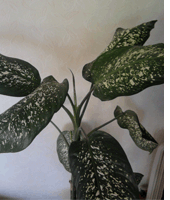 dieffenbachia
dieffenbachia
Not all housewives who prefer an abundance of flowers in the house know that such a beautiful and stately plant as dieffenbachia contains poisonous juice in its leaves. And this is true, and if you also have pets, then you need to carefully monitor that they do not gnaw this plant.
In principle, dieffenbachia loves light, but diffused, in no case direct sunlight, especially in the summer season. But in winter, additional lighting will only be glad.
This plant belongs to moisture-loving, as it has wide leaves and in general it comes from the tropical forests of South America. Therefore, during the period of active growth from spring to autumn, it needs good watering.
Propagated, either by daughter shoots or cuttings, depending on the species. It is especially good to use the upper part of the dieffenbachia for this, so that it does not rest against the ceiling.
dieffenbachia care
By and large, the plant is unpretentious, and yet, due to its southern origin, it loves high temperatures up to 30 degrees and at the same time humidity. To comply with the latter condition, it is good to have a humidifier in the house, as well as periodically wipe the leaves with a damp sponge. Spraying will not hurt, especially in the hot season.
Like many others, Dieffenbachia does not tolerate drafts, but loves fresh air. Therefore, in winter you can get by with airing, and in summer the flowers live perfectly on the balcony in its shady side.
It is also important to know the measure in watering so that the roots do not rot, but at the same time, the earth should not dry out, but be slightly moistened all the time. Do not forget about fertilizers when the plant is in the active growth phase.
Mature specimens shed their lower leaves, often grow to the ceiling and resemble a palm on a thick trunk, with leaves only at the top. If you do not want the flower to grow, cut off the crown, leaving this cutting for rooting, and the trunk can be cut about ten centimeters from the roots - fresh shoots will come from it.
When transplanting, use mainly peat soil. To four parts of peat, add two parts of soddy soil and one part of sand. However, for cuttings, peat and sand are used one to one. Otherwise, you need to follow the basic rules for transplanting indoor plants (provide for the choice of a pot, according to the size of the roots, a drainage layer, etc.).
Dieffenbachia diseases
Associated with improper care. If watering is insufficiently provided and the temperature in the room is uncomfortable for normal growth and development, then the leaves turn yellow and then fall off. Spots appear on the leaves from direct sunlight, so it is better to immediately remove the flower to a neutral zone. Unfortunately, dieffenbachia, despite its toxicity, is also susceptible to common flower pests.
Houseplant Care
![]() Transplanting Houseplants
Transplanting Houseplants
![]() Flower Pots: How to Choose
Flower Pots: How to Choose
![]() Houseplant Pests
Houseplant Pests
![]()
![]()
Houseplant Propagation Houseplant
![]() Fertilizers Hydroponics
Fertilizers Hydroponics
![]() Alocasia
Alocasia
![]() Aloe
Aloe
![]() Pineapple
Pineapple
![]() Araucaria
Araucaria
![]() Asparagus
Asparagus
![]() Aphelandra
Aphelandra
![]() Begonia
Begonia
![]() Geranium
Geranium
![]() Dieffenbachia
Dieffenbachia
![]()
![]()
Dracaena
![]() Cacti
Cacti
![]() Kalanchoe
Kalanchoe ![]()
Euphorbia
![]() Monstera
Monstera
![]() Tradescantia Ficus
Tradescantia Ficus
![]() Cyclamens
Cyclamens
PS If you liked the article, please press the buttons of social networks.

Leave a comment